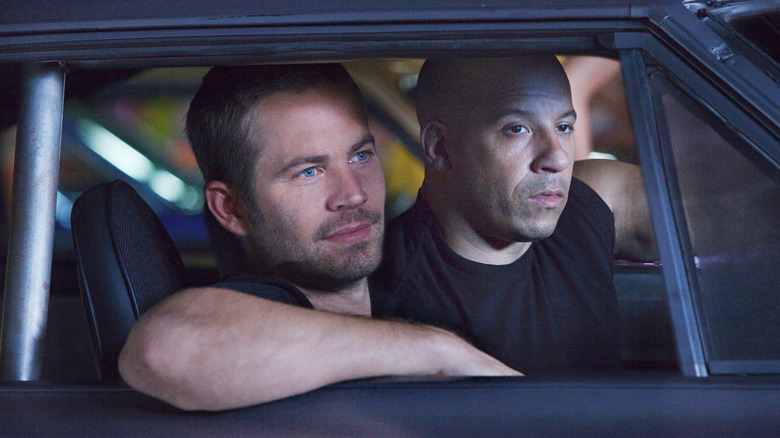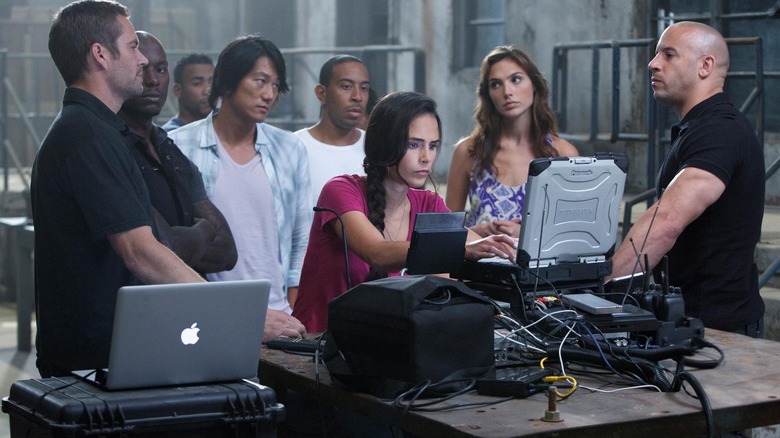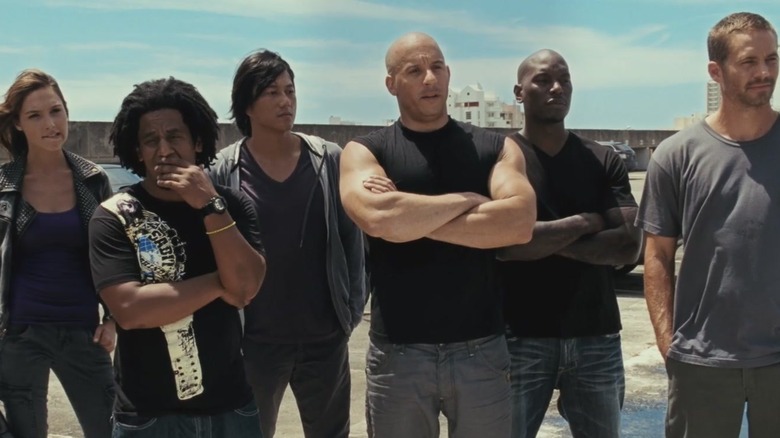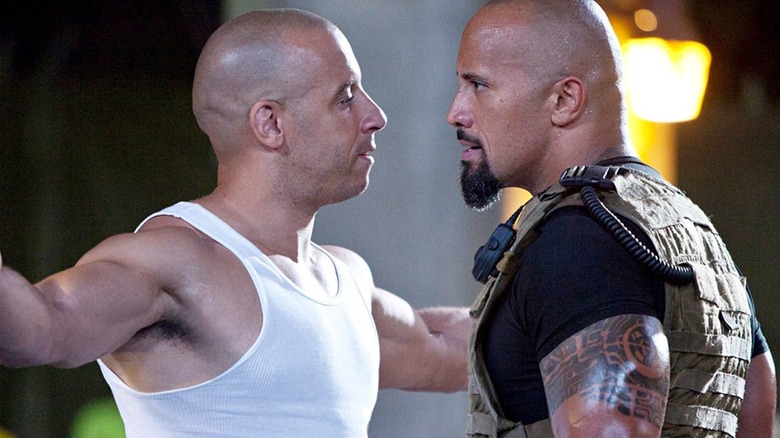Why Fast Five Is One Of The Greatest Action Movies Of All Time
The evolution of the "Fast & Furious" film series hasn't been so much an act of growth as it has been a mutation. Rob Cohen's 2001 original, "The Fast and the Furious," was little more than a low-expectation, mid-budget summer action flick that was expected to come and go in the public consciousness quite quickly. It was also very clearly cribbing its plot directly from Kathryn Bigelow's decade-old film "Point Break." Cohen merely transposed the 1991 film's setting from the world of criminal surfers to the world of criminal street racers. Vin Diesel is Patrick Swayze and Paul Walker is Keanu Reeves.
But the film ended up a major hit, grossing over $200 million worldwide, and inspiring a sequel with the amusing title of John Singleton's 2003 chapter "2 Fast 2 Furious." Because Diesel didn't return, Walker's character was teamed up with a rival played by Tyrese Gibson. Perhaps unwittingly, an ensemble began to grow.
The third film in the series, Justin Lin's 2006 entry "The Fast and the Furious: Tokyo Drift" was clearly intended to be a spinoff, featuring an all-new cast of characters. Again, however, "Tokyo" was unwittingly laying the groundwork for a large cast of characters that would interlink with other movies. It might have also helped that the "Toyko" character of Han (Sung Kang) was already ported over from Lin's film "Better Luck Tomorrow."
Lin's 2009 follow-up "Fast & Furious" looked back to the original and re-assembled many of the characters from the previous three movies. Sadly, that installment was so badly written and filmed, that it wasn't very fun to watch. But then, in 2011, alchemy. Lin's third go at the franchise, "Fast Five," cracked out of its shell and the series transformed into something glorious. "Fast & Furious" moved from mere entertainment into the realm of art.
The purity of cinema
"Fast Five" assembled as many characters as it could, and put them on the lam in Rio de Janeiro. Thanks to the events of "Fast & Furious," the cast were now all wanted by the federal government, making them righteous, outcast rogues. "Fast Five" also threw logic to the wind, giving many of the character espionage skills they couldn't possibly have picked up in their days boosting DVD players from trucks.
They were also charming enough to have attracted additional government agents, notably a Mossad operative in Gisele (Gal Gadot). Additionally, they had attracted the ire of a legitimate supervillain (Joaquim de Almeida), which organically put the protagonists into the position of outlaw superheroes. One could see that Dom Toretto may be on the wrong side of the law, but his belief in family, and the depiction of "the law" as an obsessed beast — Hobbs (Dwayne Johnson) — further turned the "Fast" crew into something mythic.
"Fast Five" turned Dom Toretto into Robin Hood. His peers were his fellow Merry Men. "Fast Five" can be compared favorably to the works of Sir Walter Scott. Only with trains, million-dollar sports cars, and hundreds of pairs of booty shorts.
One of the base functions of cinema is exploitation entertainment. Many people go to the movies to see pretty people, exotic locales, fast cars, vicious violence, human blood, and nude bodies. Cinema is well-suited to catering to humanity's lizard-brain desires. "Fast Five" realized that it already had four of the six above elements, and made something that was, essentially, a high-octane version of an old-school Saturday matinee. Indeed, "The Fast and the Furious" was the title of a 1954 exploitation B-movie produced by Roger Corman.
"Fast Five," then, drew directly from cinema history.
B-movie traditions
The story of "Fast Five" is the opposite of simple. Dom (Vin Diesel), Brian (Paul Walker), and Mia (Jordana Brewster) are framed for the killing of several DEA agents during a high-speed train heist. On the lam, Dom discovers from an old friend (Matt Schulze) that one of the cars was housing a contraband computer chip, an item very valuable to a local drug kingpin named Reyes (Joaquim de Almeida).
What follows is a repeated, righteous assault on Reyes' criminal resources, an assault that climaxes with a pair of sports cars, driven by Dom and Brian, hauling a disembodied 10-ton bank vault behind them with cables. The cars whip around corners and use the bank vault itself as a massive wrecking ball. It's one of the better driving sequences in cinema history.
The stakes are high, and the characters are massive both emotionally and physically — Dwayne Johnson in particular looks like four refrigerators stacked together. "Fast Five" was the first film in the series to swing so hard and aim so high. It was so enjoyably over-the-top that since then, the "Fast" films have only ratcheted up the ensemble, the action, and the budgets. "F9" saw a car launch into space. "Fast X" is said to cost $340 million.
The funny thing is, "Fast Five" would not have functioned as the raucous entertainment it was without the four less ambitious films before it. Audiences would not have accepted Dom Toretto as a modern-day Robin Hood without a minor cinematic legacy behind him. The Merry Men would not be the rich ensemble they were without their gradual introduction. "Fast Five" cemented the "Fast & Furious" movies as a legitimate force in cinema. Five additional films later, it's only become more accurate.
Better than Star Wars, better than the MCU
In a way, the "Fast & Furious" movies — all hinging on the tone of "Fast Five" — have essentially done naturally what other enormous film franchises like "Star Wars" and the Marvel Cinematic Universe have all done inorganically. Like "Star Wars," they draw on the corny, baseline entertaining elements of B-movie history. (After all, "Star Wars" was more or less a big-budget remake of low-budget sci-fi serials like "Flash Gordon.") Like the MCU, they introduce smaller elements and minor characters early on, only to assemble them in a massive team-up later.
But "Fast Five" did it better. Modern "Star Wars" has long ago lost sight of its B-serial origins, commenting less on the history of cinematic exploitation entertainment, and has turned into a mere comment on itself. The "Fast & Furious" movies, even by chapter 10, are still hearkening back to 1950s matinee fun. It just gets bigger and bigger. The MCU, meanwhile, was a carefully calculated movie series constructed like TV.
The MCU introduced characters quite deliberately, hoping audiences would key into promises of things to come. The MCU advertised its future installments. The "Fast & Furious" movies, in contrast, lived in the moment, building out a team as they go. (Well until "Fast Five" anyway, when the franchise began setting up future plot points and characters, including the return of Letty and the introduction of Jason Statham.)
It also helps that Dom and his crew are so appealing, warm, and righteous, that even villains eventually join their cause. The character of Shaw (Statham) was introduced as a vicious serial killer. Now he fights for good and takes care of babies. "Fast Five" let Dom and his company become so heroic that they exploded into superhuman aspirational figures. Apart from the works of Andy Sidaris, I can think of no other action series that has done it.



